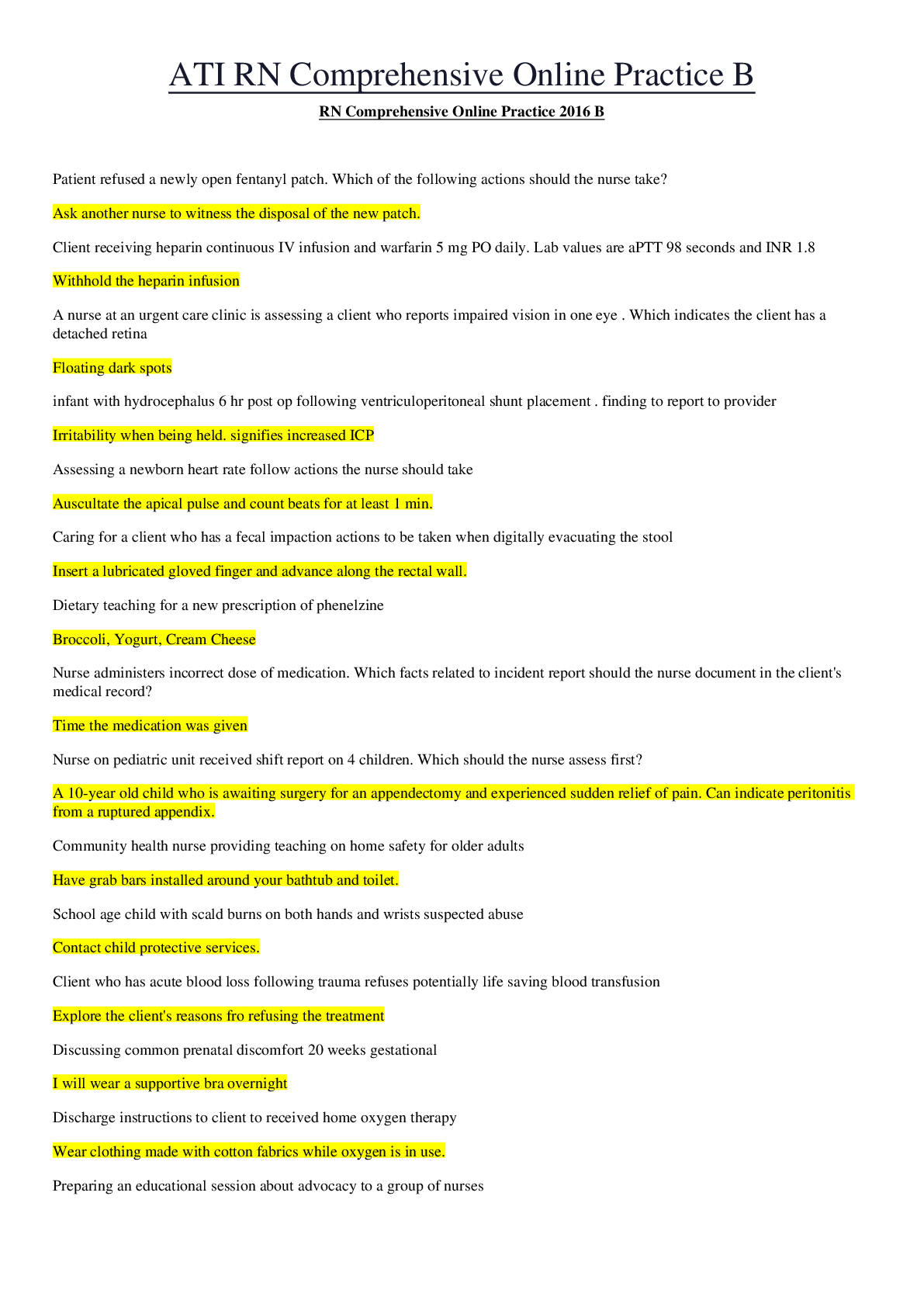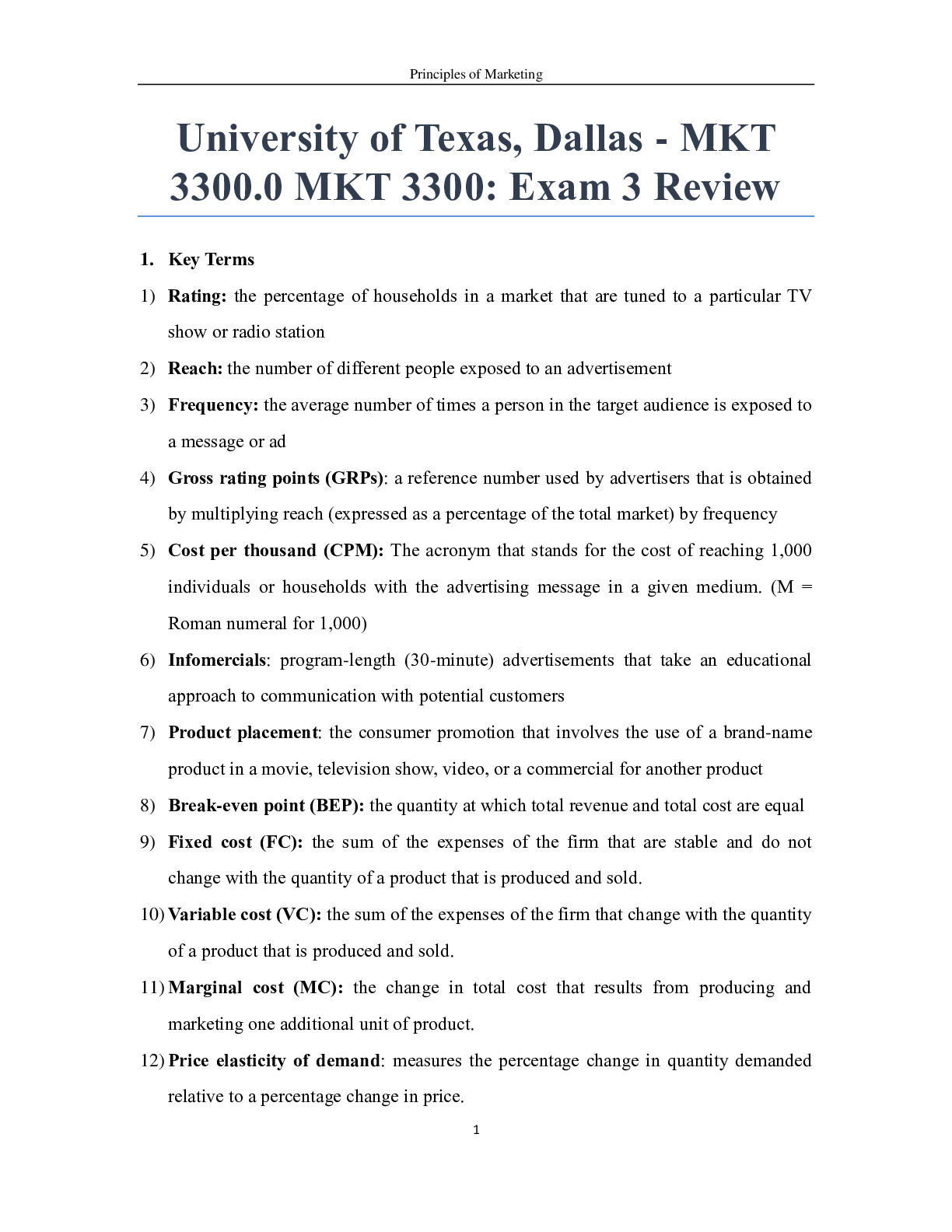Psychology > EXAM > NURS 3481 Psych Exam 2 Review 2020 – University of Texas | NURS3481 Psych Exam 2 Review 2020 (All)
NURS 3481 Psych Exam 2 Review 2020 – University of Texas | NURS3481 Psych Exam 2 Review 2020
Document Content and Description Below
NURS 3481 Psych Exam 2 Review – University of Texas Psych Exam 2 Review Top of Form Read and Review chapters, end-of-chapter review questions, EAQ questions and critical thinking questions. ... Review videos, NCLEX questions, and case studies from Evolve (Depression, Major Depressive Disorder, and Alcoholism). Compare and contrast objectives with chapter content. Safety is always the first priority. Explore the relationship between emotions, stress and functioning of the immune system. Stress negatively impacts the body’s ability to produce a protective structure. Stress can cause autoimmune disorders, immunodeficiency, and hypersensitivities. During stress, cytokines are released, which heightens the immune system. Cytokines activate corticosteroids, which in turn inhibits the immune system. Explore the relationship between mood, anxiety and exercise. Exercise decreases anxiety, and it elevates mood. This is due to endorphin release. Exercise for at least 30 minutes three times a week. Compare and contrast techniques designed to promote stress reduction and relaxation including progressive relaxation, Benson’s techniques, guided imagery, breathing exercises and give examples of each and criteria to gauge success. Progressive relaxation: anxiety tenses muscles, and this technique deliberately tenses muscle and then ultimately relaxes them. Tighten one muscle group at a time for eight seconds and then release it. There are no external gauges or feedback for this exercise. Benson’s Technique: Adopt a calm and passive attitude and focus on a pleasant mental image in a calm and peaceful environment. This relaxation response switches the body from fight-or-flight to a parasympathetic state. With medication, this technique has been found to treat hypertension, chronic pain, irregular heartbeats, insomnia, anxiety, infertility, depression, and migraines. Guided Imagery: Picture images that are relaxing to the patient. This has been found to lower cortisol, epinephrine, and catecholamine levels in patients. It also produces endorphins that increase pain threshold and enhance lymphocyte proliferation. - - - - - - - - - - - - - - - - - - - - - - - - - - - - - - - Discuss defense mechanisms used by patients experiencing anger and aggression and give examples of how and why each of these might be utilized and the purpose they serve. I can’t find this if anybody can help yay Discuss the concept of least to most restrictive interventions with the agitated, aggressive patient, including: the use of anger-control assistance, best medications to diffuse the patient’s agitation, other interventions to resolve the situation and the purpose of these interventions in terms of patients’ milieu and health professionals. Using least to most restrictive interventions means starting with the least restrictive form of de-escalation, and only going to the highest point necessary to keep patients and staff safe; the most commonly used medications are Haldol, olanzapine, ziprasidone, and lorazepam. Benadryl is commonly given as well to prevent reaction. Compare and contrast seclusion and restraint and discuss this process of this intervention from least to most including the role of the R.N., documentation and legal implications. Seclusion: the involuntary confinement of a patient alone in a room, or area from which the patient is physically prevented from leaving; if the patient is pregnant, has COPD, head or spine injury, seizure disorder, abuse, history or surgery, morbid obesity, or sleep apnea Restraint: any manual method, physical or mechanical device, material, or equipment, that immobilizes or reduces the ability of the patient to move his or her arms, legs, body, or head freely Describe behavioral and physiological indicators of the patient progressing from anger and aggression and discuss coping strategies that you can teach that will help your patient identify triggers and more appropriately deal with emotions that may precipitate a negative outcome. Box 27-4 Box 27-2 [Show More]
Last updated: 2 years ago
Preview 1 out of 16 pages

Buy this document to get the full access instantly
Instant Download Access after purchase
Buy NowInstant download
We Accept:

Reviews( 0 )
$12.50
Can't find what you want? Try our AI powered Search
Document information
Connected school, study & course
About the document
Uploaded On
Aug 06, 2020
Number of pages
16
Written in
Additional information
This document has been written for:
Uploaded
Aug 06, 2020
Downloads
0
Views
111








 – University of the People.png)

















